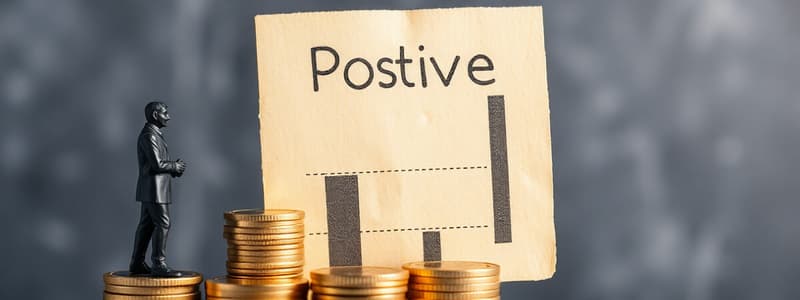Podcast
Questions and Answers
Which statement exemplifies normative economics?
Which statement exemplifies normative economics?
- Taxes should be lowered to encourage investment. (correct)
- The current unemployment rate is 5%.
- Increased government spending can stimulate economic growth.
- Inflation rose by 2% last quarter.
Which of the following relies most heavily on value judgments?
Which of the following relies most heavily on value judgments?
- Predicting future economic growth based on current trends.
- Describing the relationship between unemployment and inflation.
- Analyzing the impact of interest rate changes on consumer spending.
- Recommending policies to reduce income inequality. (correct)
What is a central focus of macroeconomics?
What is a central focus of macroeconomics?
- Pricing strategies of individual firms.
- Consumer behavior in specific markets.
- National income and output. (correct)
- Optimal resource allocation for a small business.
If a country decides to increase production of military goods, what economic problem does this decision primarily address?
If a country decides to increase production of military goods, what economic problem does this decision primarily address?
A company is deciding whether to automate a production process with robots or hire more workers. Which central problem of an economy does this decision directly address?
A company is deciding whether to automate a production process with robots or hire more workers. Which central problem of an economy does this decision directly address?
In economics, what does the term 'opportunity cost' refer to?
In economics, what does the term 'opportunity cost' refer to?
What is the primary tool used in microeconomics for analysis.
What is the primary tool used in microeconomics for analysis.
Which of the following is an example of a microeconomic study?
Which of the following is an example of a microeconomic study?
Which concept is MOST closely associated with macroeconomics?
Which concept is MOST closely associated with macroeconomics?
What is assumed to be constant when studying microeconomics?
What is assumed to be constant when studying microeconomics?
If an economy decides to produce more capital goods and fewer consumer goods, what long-term outcome is MOST likely?
If an economy decides to produce more capital goods and fewer consumer goods, what long-term outcome is MOST likely?
What is the impact of choosing a capital-intensive technique of production?
What is the impact of choosing a capital-intensive technique of production?
A city government is deciding whether to invest in a new public transportation system or improve existing roads. What economic concept BEST describes this scenario?
A city government is deciding whether to invest in a new public transportation system or improve existing roads. What economic concept BEST describes this scenario?
What is the MOST direct implication of limited resources and unlimited wants?
What is the MOST direct implication of limited resources and unlimited wants?
In the context of 'for whom to produce,' what does an economy primarily decide?
In the context of 'for whom to produce,' what does an economy primarily decide?
An individual has the option to invest in stocks, bonds, or real estate. They choose to invest in bonds. What represents their opportunity cost?
An individual has the option to invest in stocks, bonds, or real estate. They choose to invest in bonds. What represents their opportunity cost?
Which of the following issues would MOST typically be studied in macroeconomics?
Which of the following issues would MOST typically be studied in macroeconomics?
What is the key distinction between labor-intensive and capital-intensive production techniques?
What is the key distinction between labor-intensive and capital-intensive production techniques?
Which of the following is most closely related to 'price theory'?
Which of the following is most closely related to 'price theory'?
A software engineer earning $70,000 per year decides to start their own company. To do so, they quit their job, foregoing their salary. What is the opportunity cost of starting the company?
A software engineer earning $70,000 per year decides to start their own company. To do so, they quit their job, foregoing their salary. What is the opportunity cost of starting the company?
Flashcards
Positive Economics
Positive Economics
Focuses on 'what is,' describing the current state of the economy with facts.
Normative Economics
Normative Economics
Focuses on 'what should be,' suggesting solutions to economic problems and involving value judgments.
Microeconomics
Microeconomics
Studies the behavior of individual units like households, firms, and specific markets.
Macroeconomics
Macroeconomics
Signup and view all the flashcards
Microeconomics tools
Microeconomics tools
Signup and view all the flashcards
Macroeconomics tools
Macroeconomics tools
Signup and view all the flashcards
Microeconomics focus
Microeconomics focus
Signup and view all the flashcards
Macroeconomics focus
Macroeconomics focus
Signup and view all the flashcards
Microeconomics mainly studies
Microeconomics mainly studies
Signup and view all the flashcards
Macroeconomics mainly studies
Macroeconomics mainly studies
Signup and view all the flashcards
Central Economic Problems
Central Economic Problems
Signup and view all the flashcards
Allocation of Resources
Allocation of Resources
Signup and view all the flashcards
What to Produce?
What to Produce?
Signup and view all the flashcards
How to Produce?
How to Produce?
Signup and view all the flashcards
For Whom to Produce?
For Whom to Produce?
Signup and view all the flashcards
Opportunity Cost
Opportunity Cost
Signup and view all the flashcards
Study Notes
Types of Economics
- There are two types of economics: positive and normative
- Positive economics focuses on "what is" or the current state of the economy, describing facts of life as they are
- Normative economics focuses on "what should be" and suggests how economic problems should be solved, and involves value judgments
- A positive economic statement is that India is an overpopulated country with consistently rising prices
- A normative economic statement is that India should not be an overpopulated country, and prices should not rise
- Positive economics is neutral, avoids economic value judgment, and describes facts, such as the manufacturing and sale of cigarettes being harmful, but does not provide policy suggestions
- Normative economics is suggestive and provides suggestions on what actions should be taken, like quitting smoking
- Positive economics studies facts, while normative economics provides suggestions and is suggestive
Branches of Economics
- Microeconomics studies the behavior of individual units
- Macroeconomics studies the behavior of aggregates
- Microeconomics examines individual's income, output, and commodity prices using demand and supply as its tools
- Macroeconomics examines nation's income, output, and consumption using aggregate demand and aggregate supply as its tools
Origin of the Terms
- "Micro" comes from the Greek word "Micros," which means small
- "Macro" comes from the Greek word "Macros," which means large
Key Differences Between Micro and Macroeconomics
- Microeconomics studies individual economic units, while macroeconomics studies the economy as a whole or aggregates
- The main tools of microeconomics are demand and supply, while the main tools of macroeconomics are aggregate demand and aggregate supply
- Microeconomics focuses on individual income and output, while macroeconomics focuses on national income and output
- Microeconomics is also known as price theory, while macroeconomics is also known as income and employment theory
- Microeconomics involves a limited degree of aggregation, focusing on individual units
- Macroeconomics involves a higher degree of aggregation, combining many factors to study the economy
Assumptions
- When studying microeconomics, macro factors are assumed to be constant
- When studying macroeconomics, micro factors are assumed to be constant
Objectives
- Microeconomics mainly studies about price
- Macroeconomics mainly studies about income and employment
Central Problems of an Economy
- Central economic problems arise due to limited resources and unlimited wants
- These problems force economies to decide what to produce, how to produce, and for whom to produce
Allocation of Resources
- Allocation of resources involves assigning limited resources to fulfill the maximum wants of society
- The three central problems are related to this allocation
What to Produce?
- Involves selecting which goods and services to produce and in what quantity
- Limited resources mean producing more of one good often means producing less of another
- Every economy has limited resources and thus cannot produce all the goods
How to Produce?
- It is about selecting the technique of production
- Techniques can be labor intensive (LIT), requiring more labor, or capital intensive (CIT), requiring more machines
- Labor intensive technique requires more labor and less money
- Capital intensive technique require more capital and less labor.
- The decision involves determining the appropriate mix of labor and capital
For Whom to Produce?
- Addresses the distribution of produced goods and services among individuals within the economy
- It involves deciding who will receive the goods and services
- Production can be categorized based on consumers like those who are poor, rich, or middle class
Opportunity Cost
- Occurs because one must lose something to get something
- Opportunity cost is the cost of the next best alternative forgone
- If working in a bank at a salary of 40,000 and forgoing 35,000 as a journalist
- Then their opportunity cost is foregoing 35,000
Studying That Suits You
Use AI to generate personalized quizzes and flashcards to suit your learning preferences.




